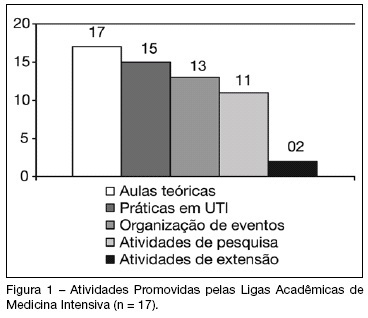Abstract
Rev Bras Ter Intensiva. 2008;20(1):43-48
DOI 10.1590/S0103-507X2008000100007
BACKGROUND AND OBJECTIVES: The Brazilian Intensive Care Medicine Association (AMIB) has been stimulating the creation of undergraduate associations/study groups on Critical Care Medicine (CCM), considering them a useful instrument to fill gaps in professional formation. The aim of this study was to evaluate the activities developed by CCM undergraduate study groups in Brazil. METHODS: The analyzed information was obtained on answers to a standard questionnaire. Contact by e-mail and/or telephone was made with representatives of all study groups registered on AMIB Committee of Undergraduate Study Groups on CCM (LIGAMI-AMIB) in September of 2007. In that period, there were 33 groups associated to LIGAMI, which 4 doesn't exist anymore, 17 answered to the sent questionnaire and the remaining 12 didn't answer the questionnaire or it was not obtained contact. RESULTS: Most study groups were founded after 2005, coinciding with the LIGAMI-AMIB Committee creation, and they are linked to one or more medical schools. Among the group's activities, the most frequent was theoretical classes (100%), usually supplied by teachers or invited physicians (69%). Other activities include practices on Intensive Care Units (88%), organization of scientific events (77%) and research projects (65%). Most study groups (65%) had already organized some scientific event such as courses and symposia; however, only three had already accomplished the AMIB CCM Introductory Course. CONCLUSIONS: The growing number of CCM undergraduate study groups in Brazil demonstrates students' interest for this specialty. Besides, there is a necessity of larger integration between existing groups to change experiences, cooperate in the accomplishment of research projects and participation on national and international events.

Abstract
Rev Bras Ter Intensiva. 2007;19(4):456-462
DOI 10.1590/S0103-507X2007000400009
BACKGROUND AND OBJECTIVES: There are deficiencies on Intensive Medicine (IM) teaching in most of medical undergraduate schools. Those deficiencies may imply damages on their clinical competence. The objective of this study was to analyze current status of IM teaching and the medical undergraduate student interest in this speciality. METHODS: A cross-sectional study was performed in 2005. We applied a self-reported questionnaire to enrolled students between the sixth and the last semesters of two medical schools from Salvador-Bahia. The questionnaire contained questions about students' interest and knowledge on IM, and opinion on IM teaching in their schools. RESULTS: We studied 570 students. Most of them (57.5%) had never realized a clerkship in intensive care unit (ICU) despite classifying its usefulness as high (mean of 4.14 ± 1.05, in a scale from 1 to 5). IM interest was high or very high in 53.7% of sample. Almost all students (97%) thought that IM topics should be more explored at their curriculum. Only 42.1% reported to be able to assess a critical care patient and this assurance was higher among students with previous clerkship in ICU (p < 0.001). Shock, cardiopulmonary resuscitation and sepsis were the most interesting topics in ICU for students' opinion. CONCLUSIONS: This study revealed a high interest in IM among medical undergraduate students. However, most had never practice a clerkship in ICU, demonstrating to be an important factor on undergraduate student performance faced to a critical care patient.
Abstract
Rev Bras Ter Intensiva. 2007;19(2):144-150
DOI 10.1590/S0103-507X2007000200002
BACKGROUND AND OBJECTIVES: Because brain death (BD) is a new concept and little divulged, it’s not well accepted in general population, including doctors and Medical students. This study aims to evaluate the knowledge of a sample of Medical students on the Brazilian BD diagnosis protocol. METHODS: Descriptive cross-sectional survey that evaluated students from two medical schools in Salvador-BA. We used a questionnaire composed by questions about technical and ethical knowledge contained in the Federal Council of Medicine’s Resolution nº 1480/97 that establishes the criteria for BD diagnosis. RESULTS: We evaluated 115 Medical students. In 14 questions about the knowledge of BD criteria, the mean of right answers were 6.7 ± 1.8, which were higher among the students that had attended some presentation on BD. Most of the students (87.4%) knew how to identify the candidates to the BD diagnosis protocol. However, only 5.2% and 16.1% of the students answered right, respectively, the clinical and complementary tests that should be accomplished during the diagnosis protocol. Facing a no-donor patient with confirmed diagnosis of BD, 66.4% referred that artificial life support should be suspended. Only 15% of the interviewed students had already evaluated a patient with BD, being this percentage higher among those who had already frequented ICU (38.2% versus 5.1%; p < 0.001). CONCLUSIONS: The results of this study showed a limited knowledge of the evaluated students on BD diagnosis criteria, mainly in relation to the practical approach of this condition.